EXPERIMENTAL STUDY ON SEDIMENT RESUSPENSION IN TAIHU LAKE UNDER DIFFERENT HYDRODYNAMIC DISTURBANCES*
Q?AN Jin, ZHENG Sha-sha, WANG Pei-fang, WANG Chao
Key Laboratory of ?ntegrated Regulation and Resource Department on Shallow Lakes, Ministry of Education and College of Enviroment, Hohai University, Nanjing 210098, China, E-mail: hhuqj@hhu.edu.cn
EXPERIMENTAL STUDY ON SEDIMENT RESUSPENSION IN TAIHU LAKE UNDER DIFFERENT HYDRODYNAMIC DISTURBANCES*
Q?AN Jin, ZHENG Sha-sha, WANG Pei-fang, WANG Chao
Key Laboratory of ?ntegrated Regulation and Resource Department on Shallow Lakes, Ministry of Education and College of Enviroment, Hohai University, Nanjing 210098, China, E-mail: hhuqj@hhu.edu.cn
(Received June 16, 2011, Revised October 26, 2011)
Contaminants resuspension in sediments induced by wind-wave could influence the water quality in shallow lakes. Resuspension of surface sediments from the Zhushan Bay, Taihu Lake was simulated under different wind forcing by using a pneumatic annular flume in this study. Acoustic Doppler Velocimeter (ADV) was used to measure flow velocity at each wind speed, and the characteristics of sediment resuspension were studied with the layered sampling technology. The experimental results show that the flow velocity increases with wind speed obviously and 6m/s is a critical wind speed which affected hydrodynamic conditions significantly. The distribution of flow velocity and water depth is different from that in ordinary open channel. With the enhanced hydrodynamic factors, the Suspended Solids Concentration (SSC) in water increases accordingly, and the incipient velocity of sediment resuspension is about 0.21 m/s. Based on the analysis of wind speed and average SSC in water column, the quantitative relationship is obtained. The SSC of the bottom layer is higher than the content of surface layer under different hydrodynamic conditions, and there are similar distributions between SSC and flow velocity in different water layers.
hydrodynamic disturbance, sediment, resuspension, wind speed, flow velocity
DO?: 10.1016/S1001-6058(10)60182-5
Introduction
Because of long fetch and shallow depth, shallow lakes are more susceptible to sediment resuspension. Sediment resuspension plays a key role in the shallow lake ecosystem, it may redistribute settled materials, increase water turbidity, and thus affect light conditions, nutrient fluxes, photosynthesis and hydrophytes community structure[1]. ?n recently years, contaminants release with the process of sediment resuspension becomes the main internal source in shallow lakes[2-4]. ?n order to estimate the amounts of released pollutants, we should understand the process of sediment resuspension. Although several hydrodynamic processes can intervene on sediment resuspension, wind-wave disturbance is usually the dominant process in shallow lakes. Hence, the study of relation between flow velocity and sediment resuspension caused by wind wave is of great importance.
Sediment resuspension is a natural process occurring when bottom shear stress is sufficiently large to disrupt the cohesion of sediment. Sediment transport under different flow conditions were well reported in previous studies[5], which described the incipient motion of sediment under different hydrodynamic situations. Wind has a significant effect on flow velocity in shallow lakes[6]. The wind surface stress induces an energetic wave-affected layer to change the hydrodynamic processes. The small depth in shallow lakes often generates a completely mixed water column during the resuspension events.
?n the investigations, it is difficult to calculate the amount of internal source release exactly in shallow lakes, and the detailed research of the relationship among wind speed, flow velocity and sediment resuspension is relatively few. Of course, there was some scholars studied a part of this problem. To study sediment resuspension in water-sediment system underdifferent hydrodynamic conditions, some instruments like Y-shape apparatus, annular tank, particle entrainment simulator[7-11]were used to produce and measure different turbulent flows. Compared to natural watersediment system, these simulative devices which depend on mechanical rabble to drive the water would destroy some original characteristics of the sediment.
?n this work, a pneumatic annular flume is used for simulating the natural wind forcing affecting on sediments of shallow lake. Compared to mechanical rabble, the advantages of this instrument is obvious. The major objectives of this study are to characterize the flow structures and processes of sediment resuspension under different hydrodynamic disturbances. The related results are expected to provide theoretical basis for estimating the release amount of sediment contaminants and sediment removal of shallow lakes.
1. Materials and methods
1.1 Experimental instrument and materials
This experiment was carried out by using a pneumatic annular flume which was a patented product of Hohai University (Patent No. 200710025671.3). The total height of the flume was 0.7 m, and the flow cross-section was 0.205 m. Wind was brought by a blast blower, and the wind speed was adjusted to the opening extent of a valve. Put the sediment and tap water into the annular flume, and then let them stand for half a month in order to approach the filed situation. According to height of the flume and the results given other researchers[12], the experimental overlying water and sediment thickness were designed to 0.40 m and 0.1 m, respectively, that was in a sediment-water ratio of 4:1.
The experimental water was just tap water from the laboratory, and the sediment materials were collected from the Zhushan Bay, Taihu Lake (31o25′24″N, 120o02′52″E) in June 2010. ?t was a semi-enclosed bay with a water area of 66 km2and water depth of 1.2 m-2 m[13].The bulk density of sediment in this area was 1.13×103kg/m3-1.46×103kg/m3with the average value of 1.3×103kg/m3[14]. The pH values of the sediments were in the range of 7.21-7.39 with an average of 7.33, displaying a slight alkaline character.
1.2 Experimental methods
The characteristic of wind is a critical factor in the change of hydrodynamic conditions in shallow lakes. According to the study of Fan[15], the frequent wind speeds of northern part of Taihu Lake were divided into four classes, including 0-1, 2-4, 5-7 and over 8 m/s. The result obtained from You[7]showed that the accumulative frequency of wind speed in the Taihu Lake was also divided into four parts and four mean values were 1.7 m/s, 3.2 m/s, 5.1 m/s and 8.7 m/s, respectively. With considering even stronger wind, 6 different wind speeds were set up. And based on the Beaufort scale, these 6 speeds corresponding with wind level 2-7. By use of a thermal anemometer, the measured experimental wind speeds were 1.60 m/s, 3.62 m/s, 6.36 m/s, 8.04 m/s, 10.38 m/s and 14.10 m/s, respectively, and they were numbered as events 1-6. The longest duration of strong wind in the Tahihu Lake was about 20 h and the mean value was about 3 h[7], so the duration of each event fixed on 8 h which insured most of the wind forcing processes were involved.
Through modulating the angle of the ventilator and the opening extent of the valve and open the fan, the wind was supplied into the pneumatic annular flume by the pipe. Water in the flume flowed immediately after wind induced. When the flow structure was stable, the velocity of water column was measured by an Acoustic Doppler Velocimeter (ADV) from bottom to water surface with 1 cm step under each wind forcing. A 60 s data were sampled at the frequency of 50 Hz using ADV at every sampling position at the perpendicular bisector of cross-section.
During each event, water samples were collected at 0 h, 0.5 h, 1 h, 2 h, 3 h, 5 h and 8 h, while sediment samples were collected at 0 h and 8 h. Samples of overlying water were collected by using a layered sampling technology which at a distance of the sediment surface 0.02 m, 0.05 m, 0.1 m, 0.2 m and 0.3 m respectively, and then collected to acid-washed polyethylene bottles. Sediment samples collected from three different locations in the annular flume, were mixed together, and then transferred to acid-washed polyethylene bags. All samples were taken to the laboratory immediately after collection. Experimental facilities and water sampling sites were represented in Fig.1.
1.3 Analytical measurements

Fig.1 Representation of experimental facility and watersampling sites (m)
Suspended Solids Concentration (SSC) of the overlying water was measured by using the gravi-metric method. 100 ml water samples were filtered through 0.45 μm cellulose acetate membrane by a vacuum filter, and then put the membranes into an oven (105oC, 4h). The content of suspended solids was calculated by the weight difference between dry and wet membrane.
The pH value of the fresh sediment samples was analyzed by a HACH pH automatic monitor. ?n the laboratory, sediment samples were freeze-dried (FD-1A-50,China), slightly crushed, passed through a 1.5× 10-4m sieve and stored at 4oC in glass bottles before analysis. Particle size analysis was performed by a laser diffraction particle analyzer (Malvern Mastersizer 2000) and the percentages of clay (<3.9μ m), silt (3.9 μm-63 μm), sand (63 μm-2 000 μm), and the Mass Median Diameter (MMD) were calculated.
For quality control, all sampling equipments were rinsed with ultrapure water. Analytical blanks and three replicates of samples were used in the determination of suspended solids contents and other physicochemical parameters.

Table 1 Essential conditions of the 6 events
2. Results and discussions
2.1 The relationship between flow velocity and wind speed
There were 6 kinds of average wind speeds in this laboratory experiment, from 1.60 m/s to 14.10 m/s corresponding to the wind levels 2-7, respectively. The main influence of water structure induced by wind was represented by the longitudinal velocity component (u). Compared to the longitudinal velocity component, lateral and vertical velocity components were relatively small, hence, the vertical distribution of longitudinal velocity component was analyzed in this study. The essential conditions of the 6 events are listed in Table 1. ?n the whole experiment, the Reynolds numbers (>1300) and Froude numbers (<1) indicated the water flow is turbulent and subcritical flow.
Flow velocity was measured after water structure reaching to a relatively stable profile, so the mean longitudinal velocity (u) represented the mean flow velocity in the flume. Figure 2 shows the significant power relationship between average wind speed (V) and mean longitudinal velocity. The equation was=0.5879V1.7683, and the R2=0.9324, indicating that wind forcing induced the hydrodynamic conditions remarkably. ?n order to verify the applicability of obtained equation, some comparisons are shown in Table 2. The flow velocities acquired by use of our equation were a litter larger than the values obtained by other researchers. Tolerances of these two values were 6%-19%. Because of experimental scale effect, the calculated values may deviate from field observations. More exact relation between flow velocity and wind speed need to do intensive research.
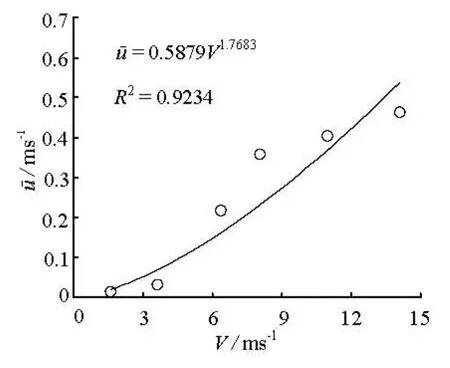
Fig.2 Relationship between mean flow velocity and wind speed

Table 2 Comparisons of mean flow velocities at different wind speeds
As a very important driving force in shallow lakes, wind plays a key role in determining flow velocity. Xu et al.[19]reported that flow velocity was determined by wind speed in the Taihu Lake. From Fig.2 we can also see that when the wind speed increased from 3.62 m/s to 6.36 m/s, the flow velocity increased sharply for the reason of the enhancement of hydrodynamic conditions (the Reynolds number was increased 6.7 times). ?n accordance with the result of Han et al.[20], wind-driven current had remarkable effect on the water column when the wind speed reached to 2.5 m/s, while the wind speed increased to 6.0 m/s, wind-driven current played a leading role in the water body. These may probably explain the dramatic flow velocity changes in the range of this wind speed.

Fig.3 Vertical distributions of longitudinal velocity component under different wind forcing
2.2 The relationship between vertical distribution of longitudinal velocity component and flow depth
Generally, the vertical distribution of longitudinal velocity in the open channel was considered to be logarithmic pattern. As different from open channel, the measured longitudinal velocity profiles for the 6 events were shown in Fig.3. From this figure, we can see that the velocity increases with the wind speeds obviously and all of the 6 longitudinal velocity components increase from bottom to surface approximately. According to simulations of measured velocity profiles, the distributions u =ke xp(c h) are found in the 6 events. Here h is the vertical distance from the bottom, k and c are constants, and R2are 0.9166, 0.8607, 0.8995, 0.9211, 0.9735 and 0.9632 for the 6 events, respectively.
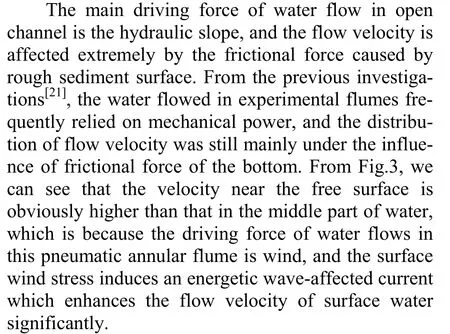
?n order to make the velocity distribution more prevalent, normalization was performed in calculating water depth and velocity. Relationships between relative longitudinal velocities and water depths at different wind speeds were obtained after the simulations for these two factors. Figure 4 shows that there exist similar distributions in the Event 1-2 and in the Event 3-6, the expressions of the relation are ur=0.3627· exp(1.9754 hr) and ur=0.6605exp(0.8422 hr), respectively. Here hr= h /H,ur=u /u, h is the water depth (i.e., the vertical distance from the bottom), and H is total water depth (0.4 m).
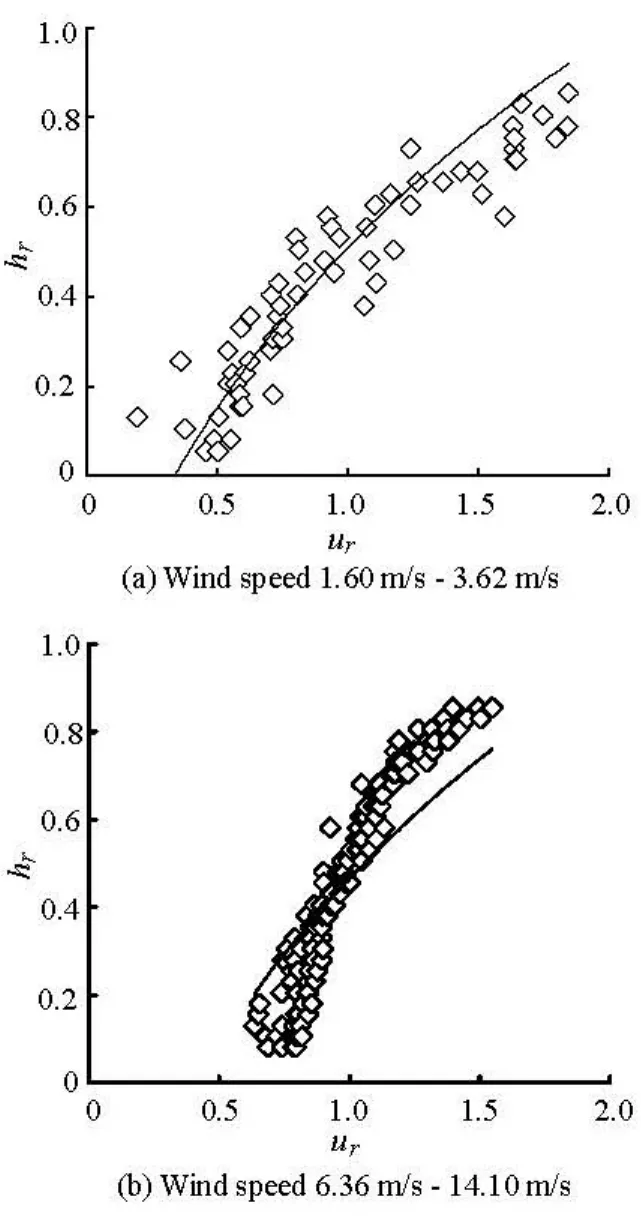
Fig.4 Relationships between relative longitudinal velocity component and flow depth
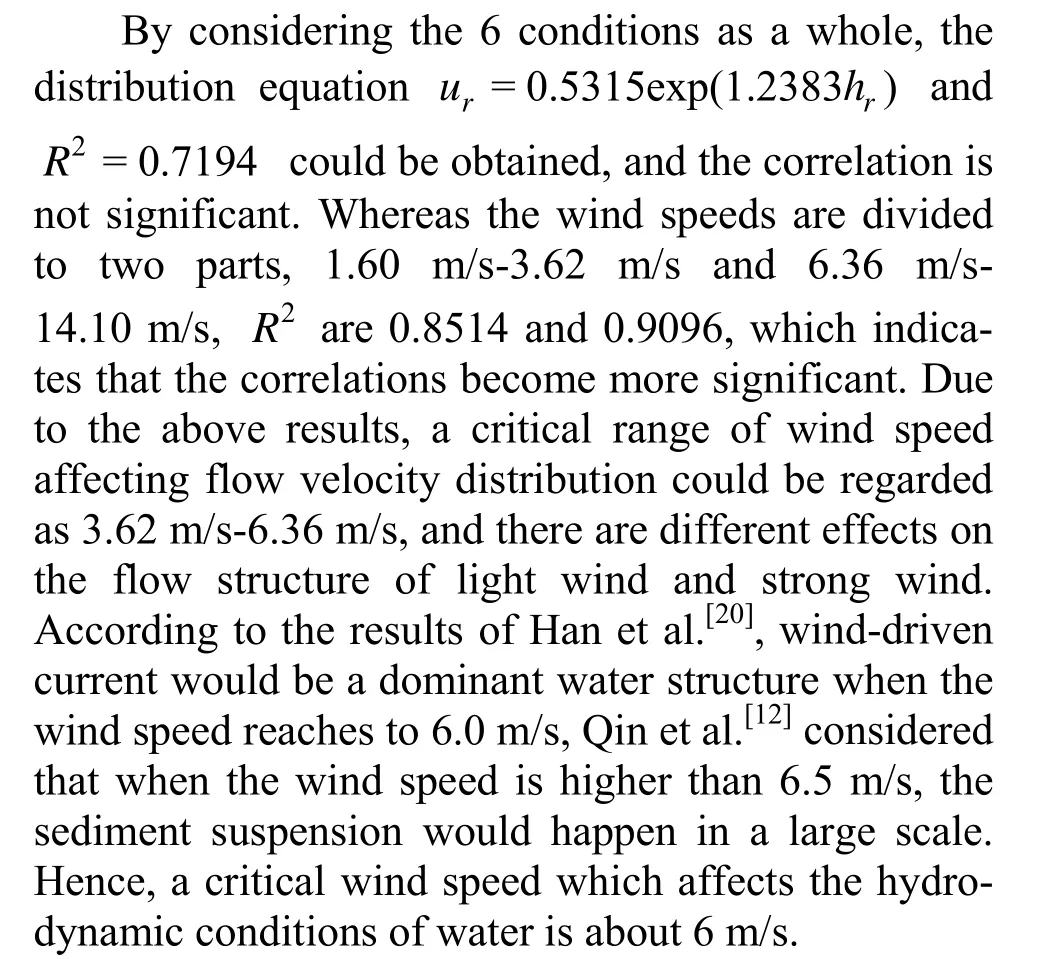
2.3 Distribution of sediment resuspension
2.3.1 Particle size distribution in experiments
Particle size is an important factor affecting the sediment resuspension. ?n this study, the particle size was divided into four ranges and no particles have the size greater than 2 000 μm in all the sediments. Thedistributions of particle size of each event (0h and 8h) are shown in Table 3. The average median particle size of sediment is 18.02 μm which is bigger than 14.4 μm[14]and 17 μm[8]of this area in the Taihu Lake. The sediments in the Lake generally contain higher fraction of clay and silt particles than in other sediments, e.g., the sediments in the Yangtze River generally contain sand particles of 50%-90% and clay particles of <10%.
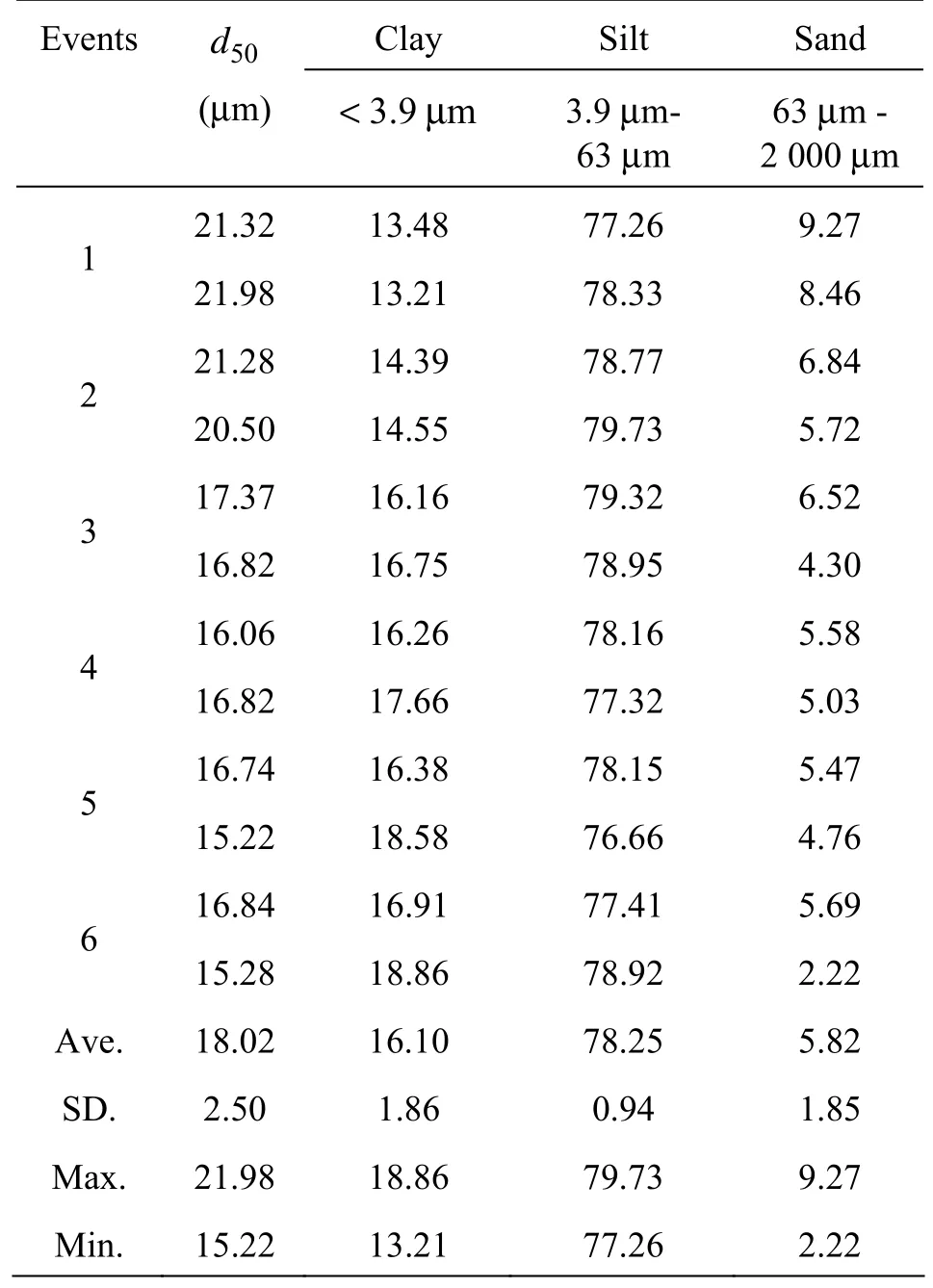
Table 3 Particle size distribution (%) in the 6 events
2.3.2 ?ncipient motion of experimental sediment
Sediment resuspension induced by wind wave is a usual phenomenon which often occurs when the bottom stress is sufficiently large to entrain material from the bed in shallow lakes and wave-current could change the bottom shear stress. When the flow velocity is in the range of 0.0151 m/s-0.0326 m/s (at the wind speed in the range of 1.60 m/s-3.62 m/s), sediment resuspension almost does not happen. While the flow velocity increases to 0.2181 m/s (wind speed: 6.36 m/s), fine particles suspend and water body becomes feculent distinctly. This phenomenon indicates that the shear stress caused by the wind wave which affecting on sediment has already reached the incipient value under this condition. According to the observation of SSC in the Taihu Lake[12], the critical wind speed range caused sediment resuspension is about 5 m/s-6.5 m/s. When the flow velocity increases from 0.3574 m/s to 0.4638 m/s (at the wind speed in the range of 8.04 m/s-14.10 m/s), the sediment suspend in a large scale. The phenomenon of sediment resuspension in this experiment is similar to that described by Li[8].
?n this study, the incipient motion of sediment is referred to the threshold condition where a few particles move over a unit area. According to previous results[22], the incipient velocity of sediment transport is in the range of 0.31 m/s-0.48 m/s when the grain size is about 18 μm, whereas the measured value is about 0.21 m/s (at the wind speed 6.36 m/s). Compared to water flow with no wave, the bottom shear stress affecting sediment transport is larger when the water body is affected by wind waves significantly, so the sediment transport is more easily under this experimental condition and the incipient velocity is smaller accordingly.
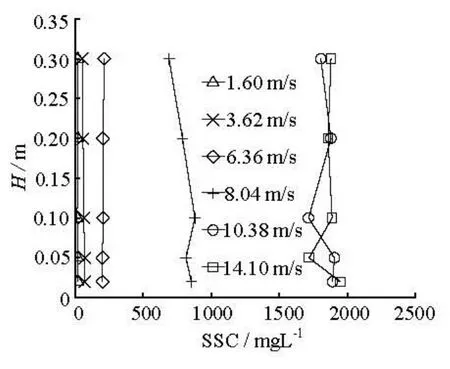
Fig.5 Vertical distribution of SSC in the overlying water under different wind forcing
2.3.3 Distribution of suspended solids in overlying water
The vertical distribution of SSC in the overlying water is shown in Fig.5. The SSC reaches a relatively stable stage after a duration of 8 h and the following discussions are all under this condition. From Fig.5 we can see that the SSC is low when the wind speed is lower than 3.62 m/s. While the wind speed reaches 6.36 m/s, the SSC increases obviously. This is the result of a proportion of particles suspended due to the increasing drag force of wind wave. At the same time, the flow velocity under this condition is supposed to incipient value. The SSC increases sharply when the wind speed changes from 6.36 m/s to 8.04 m/s and 8.04 m/s to 10.38 m/s, indicating that the sediment resuspention happens prevalently with the enhanced hydrodynamic factors. Under the last wind forcing, the SSC is as much as that at the wind speed 10.38 m/s.
The average contents of SS in the events 1-6 are 17 mg/L, 62 mg/L, 203 mg/L, 805 mg/L, 1 740 mg/L and 1 859 mg/L, respectively. Sediment resuspension in the Taihu Lake have been observed by someresearchers. Qin et al.[12]found that in the northern part of the Taihu Lake, the contents of SS are about 20 mg/L, 40 mg/L and 200 mg/L at the wind speeds of 2.6 m/s, 5.0 m/s and 6.5 m/s, respectively. Hu et al.[23]demonstrated that the SSC concentrates in 25 mg/L-200 mg/L and 180 mg/L-2 000 mg/L when the water body experiences light wind wave (at the wind speed in the range of 1.4 m/s-4.3 m/s) and strong wind wave (wind speed: 5.7 m/s-9.3 m/s) accordingly. The results obtained in this study correspond well with above conclusions. By an indoor simulation, You et al.[7]reported that the SSC would be 111 mg/L, 159 mg/L, 230 mg/L and 425 mg/L at the wind speeds of 1.7 m/s, 3.2 m/s, 5.1 m/s and 8.7 m/s. His results were a litter different from ours.
The vertical distribution of SSC changed slightly of the former three kinds of wind speeds while changed obviously under the later three conditions indicated that sediment particles could be dragged into water with the enhanced hydrodynamic conditions. The SSC of the bottom layer was higher than that of surface layer in all conditions showing that wind-wave disturbance had a significantly influence on the SSC at the bottom. When the sediment was disturbed by water flow, different sizes of particles were carried to overlying water. After a period of time, large particles settled down due to gravity, while small particles suspended in the upper water. Preview studies including the observations of fieldwork[23,24]had the similar conclusions.

Fig.6 Relationship between average SSC and wind speed
2.3.4 Relationship among wind speed, flow velocity and sediment resuspension
Some researchers used the equation SSC= αVβ+SSCas a mathematical function linking SSC
0 with wind speed (V) in the fieldworks[24]. SSC0would correspond to the background value, which does not depend on wind forcing resuspension, and α and β depend on the characteristics of the process of particles resuspension from the bottom. The equation obtained in this work follows this pattern (see Fig.6). The average SSC in overlying water is adequately correlated with the wind speed (R2= 0.9554) which suggests a good reliability in use of calculating the SSC caused by wind waves. Other expressions, such as the exponential function[7], were found in laboratory simulation. But the obtained expression in this work is more coincident with the field observations for shallow lakes.
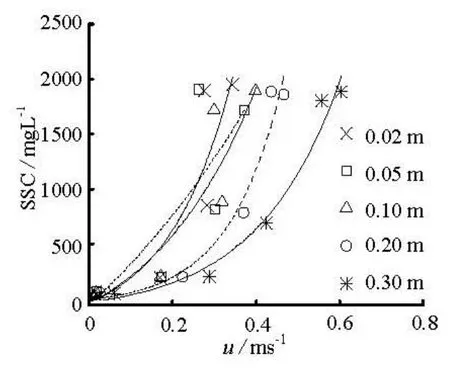
Fig.7 Relationship between SSC and flow velocity in different water layers
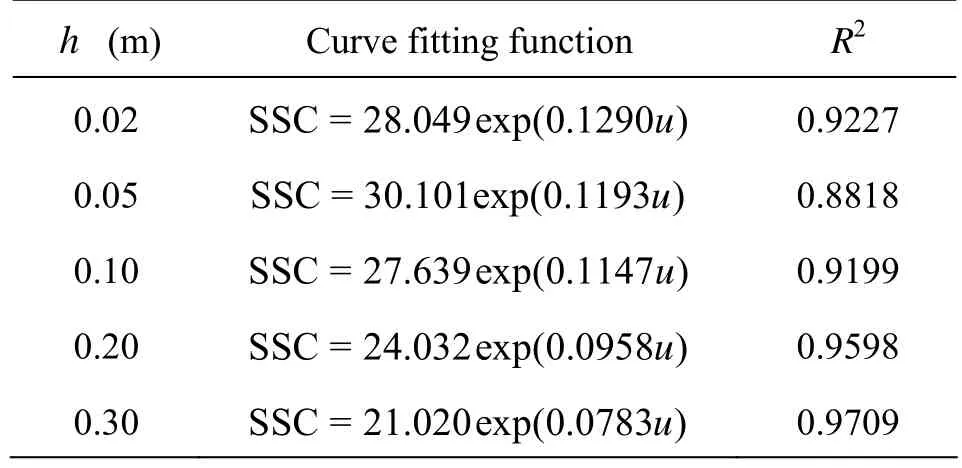
Table 4 Relationship between SSC and flow velocity indifferent layers at the relatively stable stage
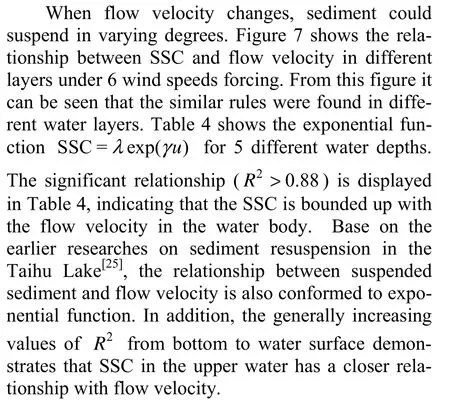
3. Conclusions
Frequent resuspension of sediment is recognizedas an important process in shallow lakes. This article presents a simulated experiment to reveal this process, and the results are summarized as follows:
(1) Flow velocity will increase in the form of power function with the growth of wind speed, and the critical wind speed which affects hydrodynamic conditions of water is about 6 m/s. The distribution of flow velocity have a small difference around the critical value. The distribution of flow velocity with water depth in the pneumatic annular flume is different from that of open channel.
(2) By means of experimental simulation of sediment from the Taihu Lake, the incipient velocity of sediment transport is about 0.21 m/s under wind-wave influence. Compared to water flow with no wave, sediment resuspension occurs more easily when water body is affected by wind-wave disturbances.
(3) With the enhanced hydrodynamic factors, the SSC in the water increases accordingly. The SSC of the bottom layer is larger than that of surface layer under different wind speed conditions indicates that wind-wave disturbance influences the SSC of the bottom water column more significantly.
(4) The correlation between average SSC in water body and wind speeds is remarkable, and these two factors could be expressed by SSC= 3.9458V2.4065+11.54. The distributions of SSC in different water layers affected by flow velocity are similar, and could be expressed by the exponential function SSC= λe xp(γu ).
Compared to other simulation methods of sediment resuspension, the pneumatic annular flume simulation is closer to realistic cases. The obtained results describe the process of sediment resuspension and provide estimation formula of SS amount under different wind-wave conditions in the Taihu Lake. Based on indoor simulation, we can know the mechanism of sediment resuspension in shallow lakes more easily. Due to the experiment scale and other interfering factors, the accuracy of acquired formula parameters need to be improved in further research.
[1] SONDRA M. M., KER? C. H. Spatial and temporal variations of persistent organic pollutants impacted by episodic sediment resuspension in southern Lake Michigam[J]. Journal of Great Lakes Research, 2010, 36(2): 256-266.
[2] AHLGREN J., RE?TZEL K. and DE BRABANDERE H. et al. Release of organic P forms from lake sediments[J]. Water Research, 2011, 45(2): 565-572.
[3] FAN Jing-yu, WANG Dao-zeng and ZHANG Kun. Experimental study on a dynamic contaminant release into overlying water-body across sediment-water interface[J]. Journal of Hydrodynamics, 2010, 22(5): 354-357.
[4] CHR?ST?AN E. W. Aerobic phosphorus release from shallow lakes[J]. Science of the Total Environment, 2011, 409(21): 4640-4641.
[5] BOHL?NG B. Measurements of threshold values for incipient motion of sediment particles with two different erosion devices[J]. Journal of Marine Systems, 2009, 75(3-4): 330-335.
[6] MAXAM A. M., WEBBER D. F. The influence of wind-driven currents on the circulation and bay dynamics of a semi-enclosed Reefal bay, Wreck bay, Jamaica[J]. Estuarine, Coastal and Shelf Science, 2010, 87(4): 535-544.
[7] YOU Ben-sheng, ZHONG Ji-cheng and FAN Chengxin et al. Effects of hydrodynamics processes on phosphorus fluxes from sediment in large, shallow Taihu Lake[J]. Journal of Environmental Science, 2007, 19(9): 1055-1060.
[8] L? Yi-ping. Study on the influence factors of transparency of experiment and numerical model in Taihu Lake[D]. Ph. D. Thesis, Nanjing: Hohai University, 2005(in Chinese).
[9] WAN Jun, WANG Ze and Q?AN Shu-qin. Distribution of bioavailable phosphorus between overlying water and SPM under abrupt expansion condition[J]. Journal of Hydrodynamics, 2011, 23(3): 398-406.
[10] HUA? Wen-xin, WU Zhen-lei and Q?AN Zhong-dong et al. Large eddy simulation of open channel flows with non-submerged vegetation[J]. Journal of Hydrodynamics, 2011, 23(2): 258-264.
[11] CANTWELL M. G., BURGESS R. M. Variability of parameters measured during the resuspension of sediments with a particle entrainment simulator[J]. Chemosphere, 2004, 56(1): 51-58.
[12] Q?N Bo-qiang, HU Wei-ping and GAO Guang et al. Dynamic mechanism and conceptual model of inner source release of sediments suspension from Taihu Lake[J]. Chinese Science Bullentin, 2003, 48(17): 1822-1831(in Chinese).
[13] YAO Shu-chun, XUE Bin. Nutrients and heavy metals in multi-cores from Zhushan Bay at Taihu Lake, the largest shallow lake in the Yangtze Delta, China[J]. Quaternary International, 2010, 226(1-2): 23-28.
[14] WANG Chao, WANG Cun and WANG Ze. Effects on submerged macrophytes on sediment suspension and NH4-N release under hydrodynamic conditions[J]. Journal of Hydrodynamics, 2010, 22(6): 810-815.
[15] FAN Cheng-xin, ZHANG Lu and Q?N Bo-qiang et al. Dynamic release estimation of phosphor from suspended solids of Taihu Lake under wind-wave effect[J]. Science in China, Ser. D (Earth Sciences), 2003, 33(3): 760-768(in Chinese).
[16] MA Wei, L?AO Wen-gen and L? Jin-xiu et al. Countermeasure of water diversion and regulation to improve the water invironment of Taihu Lake and prediction of its effect[J]. Resources and Environment in the Yangtze Basin, 2007, 16(1): 52-56(in Chinese).
[17] TANG Lu-lu, WANG Peng and YAO Qi. Three-dimensional numerical simulation of current, waves and sediment transport in Taihu Lake[J]. Water Resources Protection, 2011, 27(2): 1-5(in Chinese).
[18] LUO Lian-cong, Q?N Bo-qiang. Numerical simulation based on a three-dimensional shallow-water hydrodynamic model in Lake Taihu-current circulations in Lake Taihu with prevailing wind-forcing[J]. Journal of Hydrodynamics, Ser. A, 2003, 18(6): 686-691(in Chinese).
[19] XU Xu-feng, L?U Qing-quan. Numerical study on the characteristics of wind-induced current in Taihu Lake[J]. Chinese Journal of Hydrodynamics, 2009, 24(4): 512-518(in Chinese).
[20] HAN Hong-juan, HU Wei-ping and J?N Yi-quan. Numerical experiments on influence of wind speed on current in lake[J]. Oceanologia Et Limnologia Sinica, 2008, 39(6): 567-576(in Chinese).
[21] WANG Pei-fang, WANG Chao and ZHU D. Z. et al. Hydraulic resistance of submerged vegetation related to effective height[J]. Journal of Hydrodynamics, 2010, 22(2): 265-273.
[22] ADEL E., YEE M. and CH?EW H. A. Effect of accelerating and decelerating flows on incipient motion in sand bed streams[J]. Advances in Water Resources, 2010, 33(9): 1094-1104.
[23] HU Chun-hua, HU Wei-ping and ZHANG Fa-bing et al. Observation of sediment resuspension in Taihu Lake[J]. Chinese Science Bullentin, 2005, 50(22): 2541-2545(in Chinese).
[24] Q?AO L. L., WANG Y. Z. and L? G. X. et al. Distribution of suspended particulate matter in the northern Bohai Bay in summer and its relation with thermocline[J]. Estuarine, Coastal and Shelf Science, 2011, 93(3): 212-219.
[25] HU Kai-ming, PANG Yong and WANG Hua et al. Simulation study on water quality based on sediment release flume experiment in Lake Taihu, China[J]. Ecological Engineering, 2011, 37(4): 607-615.
* Projected supported by the National Key Basic Research Development Program of China (973 Program, Grant No. 2008CB418203), the National Key Program of National Natural Science Foundation of China (Grant No. 50830304) and the National Natural Science Foundation of China (Grant No. 50909035).
Biography: Q?AN Jin (1974-), Male, Ph. D., Lecturer
WANG Pei-fang, E-mail: pfwang2005@hhu.edu.cn
- 水動力學研究與進展 B輯的其它文章
- NUMERICAL STUDY OF HYDRODYNAMICS OF MULTIPLE TANDEM JETS IN CROSS FLOW*
- NUMERICAL SIMULATION OF HYDRODYNAMIC CHARACTERISTICS ON AN ARC CROWN WALL USING VOLUME OF FLUID METHOD BASED ON BFC*
- DYNAMIC ANALYSIS OF FLUID–STRUCTURE INTERACTION OF ENDOLYMPH AND CUPULA IN THE LATERAL SEMICIRCULAR CANAL OF INNER EAR*
- SIMULATIONS OF FLOW INDUCED CORROSION IN API DRILLPIPE CONNECTOR*
- NUMERICAL SIMULATION OF FLOW OVER TWO SIDE-BY-SIDE CIRCULAR CYLINDERS*
- LABORATORY STUDIES ON WAVE FORCE OF COASTAL STRUCTURES MADE OF FLAT GEOTUBES*

